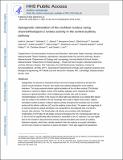Optogenetic stimulation of the cochlear nucleus using channelrhodopsin-2 evokes activity in the central auditory pathways
Author(s)
Darrow, Keith N.; Slama, Michaël C.C.; Kozin, Elliott D.; Owoc, Maryanna; Hancock, Kenneth; Kempfle, Judith; Edge, Albert; Lacour, Stephanie; Boyden, Edward; Polley, Daniel; Brown, M. Christian; Lee, Daniel J.; ... Show more Show less
DownloadBoyden_Optogenetic stimulation.pdf (1.865Mb)
PUBLISHER_CC
Publisher with Creative Commons License
Creative Commons Attribution
Terms of use
Metadata
Show full item recordAbstract
Optogenetics has become an important research tool and is being considered as the basis for several neural prostheses. However, few studies have applied optogenetics to the auditory brainstem. This study explored whether optical activation of the cochlear nucleus (CN) elicited responses in neurons in higher centers of the auditory pathway and whether it elicited an evoked response. Viral-mediated gene transfer was used to express channelrhodopsin-2 (ChR2) in the mouse CN. Blue light was delivered via an optical fiber placed near the surface of the infected CN and recordings were made in higher-level centers. Optical stimulation evoked excitatory multiunit spiking activity throughout the tonotopic axis of the central nucleus of the inferior colliculus (IC) and the auditory cortex (Actx). The pattern and magnitude of IC activity elicited by optical stimulation was comparable to that obtained with a 50 dB SPL acoustic click. This broad pattern of activity was consistent with histological confirmation of green fluorescent protein (GFP) label of cell bodies and axons throughout the CN. Increasing pulse rates up to 320 Hz did not significantly affect threshold or bandwidth of the IC responses, but rates higher than 50 Hz resulted in desynchronized activity. Optical stimulation also evoked an auditory brainstem response, which had a simpler waveform than the response to acoustic stimulation. Control cases showed no responses to optical stimulation. These data suggest that optogenetic control of central auditory neurons is feasible, but opsins with faster channel kinetics may be necessary to convey information at rates typical of many auditory signals.
Date issued
2014-12Department
Massachusetts Institute of Technology. Department of Biological Engineering; Massachusetts Institute of Technology. Department of Brain and Cognitive Sciences; Massachusetts Institute of Technology. Media Laboratory; McGovern Institute for Brain Research at MIT; Program in Media Arts and Sciences (Massachusetts Institute of Technology)Journal
Brain Research
Publisher
Elsevier
Citation
Darrow, Keith N., Michaël C.C. Slama, Elliott D. Kozin, Maryanna Owoc, Kenneth Hancock, Judith Kempfle, Albert Edge, et al. “Optogenetic Stimulation of the Cochlear Nucleus Using Channelrhodopsin-2 Evokes Activity in the Central Auditory Pathways.” Brain Research 1599 (March 2015): 44–56.
Version: Author's final manuscript
ISSN
0006-8993